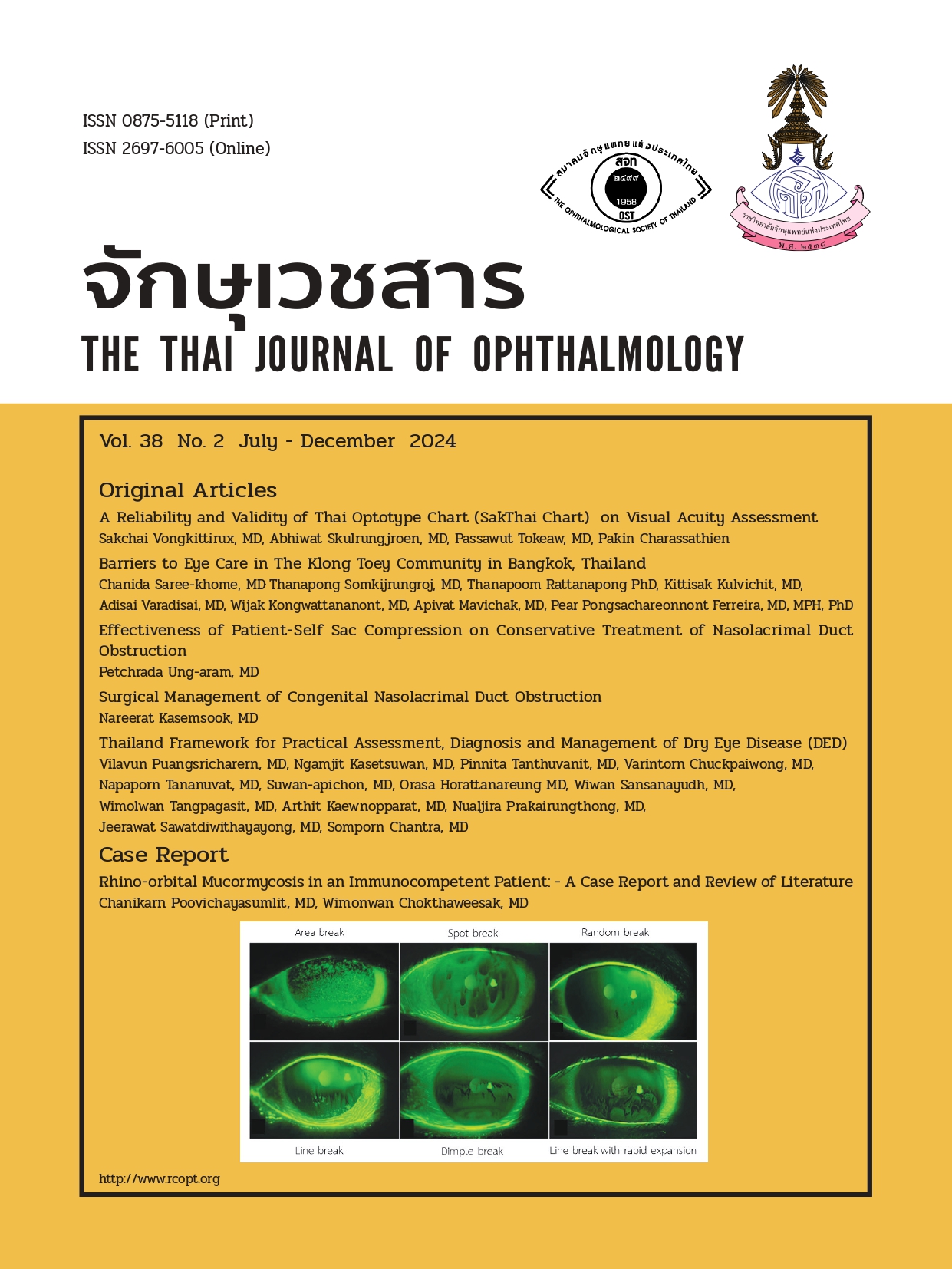A Reliability and Validity of Thai Optotype Chart (SakThai Chart) on Visual Acuity Assessment
Keywords:
Reliability, Validity, Visual Acuity, Snellen Chart, Thai Visual Acuity TestAbstract
Objective: To examine the accuracy of the Thai Visual Acuity Test (SakThai Chart) for measuring visual performance.
Study Design: A cross-sectional study designed to test reliability and validity was conducted with 124 participants aged 20-65 years. These subjects voluntarily underwent visual acuity testing at the ophthalmology department of Thammasat University Hospital. The assessment involved reading both the numeric optotype chart and the Thai language visual acuity test (SakThai Chart) with the right eye, with subsequent result documentation. Data analysis was performed using SPSS version 25. The reliability of the instrument was evaluated using Pearson correlation, while validity was assessed through the Item-Objective Congruence (IOC) index and paired t-test.
Results: The Thai language visual acuity test (SakThai Chart) demonstrated a Pearson correlation coefficient of
0.992, indicating high reliability when compared to the Snellen Chart. Validity testing revealed IOC values exceeding
0.5 for all items. The paired t-test showed no statistically significant difference between the two instruments (P-value = 0.217).
Conclusion: The Thai language visual acuity test (SakThai Chart) exhibited high reliability with excellent correlation with numeric optotype chart. It demonstrated high content validity and can be considered a viable alternative to the numeric optotype chart for visual acuity assessment.
References
Snellen H. Test-types for the Determination of the Acuteness of Vision. Utrecht: P.W. van de Weijer; 1862.
de Jong PTVM. A history of visual acuity testing and optotypes. Acta Ophthalmol. 2022;100(7):e1337-e1349.
Rozhkova G, Lebedev D, Gracheva M, Rychkova S. Optimal Optotype Structure for Monitoring Visual Acuity. Perception. 2017;46(3-4):321-331.
Sailoganathan A, Siderov J, Osuobeni E. A new Gujarati language logMAR visual acuity chart: Development and validation. Indian J Ophthalmol. 2013;61(10):557-561.
Ruamviboonsuk P, Tiensuwan M. Visual acuity measurement using a new Thai language logarithmic visual acuity chart and a standard chart. J Med Assoc Thai. 2002;85(7):808-815.
Bailey IL, Lovie-Kitchin JE. Visual acuity testing. Fromthe laboratory to the clinic. Vision Res. 2013;90:2-9.
Ferris FL 3rd, Kassoff A, Bresnick GH, Bailey I. New visual acuity charts for clinical research. Am J Ophthalmol. 1982;94(1):91-6.
Dandona L, Dandona R, Srinivas M, et al. Moderate visual impairment in India: the Andhra Pradesh Eye Disease Study. Br J Ophthalmol. 2002;86(4):373-7.
Bourne RR, Rosser DA, Sukudom P, et al. Evaluating a new logMAR chart designed to improve visual acuity assessment in population-based surveys. Eye (Lond). 2003;17(6):754
Rosser DA, Laidlaw DA, Murdoch IE. The development of a "reduced logMAR" visual acuity chart for use in routine clinical practice. Br J Ophthalmol. 2001;85(4):432-6.
Arditi A, Cagenello R. On the statistical reliability of letter-chart visual acuity measurements. Invest Ophthalmol Vis Sci. 1993;34(1):120-9.
Jenchitr W, Hanutsaha P, Iamsirithaworn S, et al. The national survey of blindness, low vision and visual impairment in Thailand. J Med Assoc Thai. 2007;90(9):1897-903.
Wong TY, Loon SC, Saw SM. The epidemiology of age related eye diseases in Asia. Br J Ophthalmol. 2006;90(4):506-11.
World Health Organization. Universal eye health: a global action plan 2014-2019. Geneva: WHO; 2013.
Kocur I, Resnikoff S, Foster A. Visual impairment and blindness in Europe and their prevention. Br J Ophthalmol. 2002;86(7):716-22.
Elliott DB, Yang KC, Whitaker D. Visual acuity changes throughout adulthood in normal, healthy eyes: seeing beyond 6/6. Optom Vis Sci. 1995;72(3):186-91.
Downloads
Published
Issue
Section
License
Copyright (c) 2024 THE THAI JOURNAL OF OPHTHALMOLOGY

This work is licensed under a Creative Commons Attribution-NonCommercial-NoDerivatives 4.0 International License.
The Thai Journal of Ophthalmology (TJO) is a peer-reviewed, scientific journal published biannually for the Royal College of Ophthalmologists of Thailand. The objectives of the journal is to provide up to date scientific knowledge in the field of ophthalmology, provide ophthalmologists with continuing education, promote cooperation, and sharing of opinion among readers.
The copyright of the published article belongs to the Thai Journal of Ophthalmology. However the content, ideas and the opinions in the article are from the author(s). The editorial board does not have to agree with the authors’ ideas and opinions.
The authors or readers may contact the editorial board via email at admin@rcopt.org.


